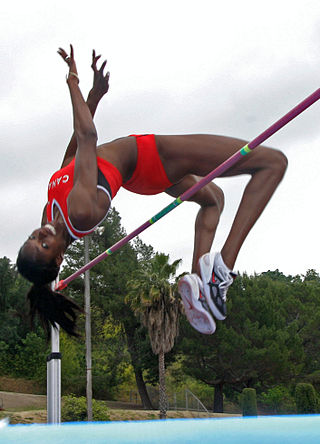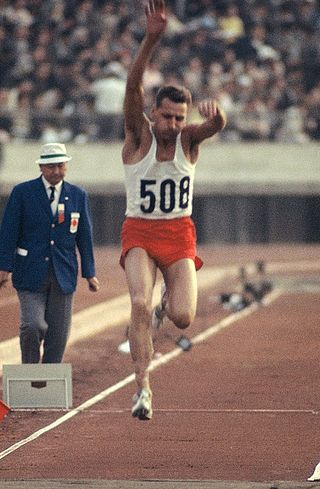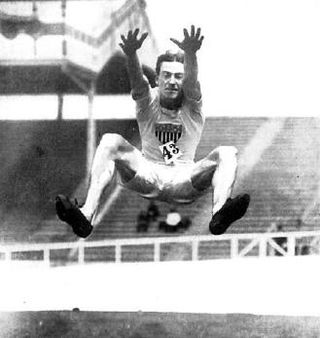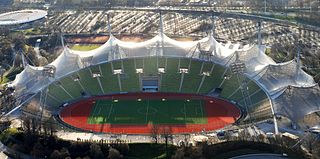
The high jump is a track and field event in which competitors must jump unaided over a horizontal bar placed at measured heights without dislodging it. In its modern, most-practiced format, a bar is placed between two standards with a crash mat for landing. Since ancient times, competitors have introduced increasingly effective techniques to arrive at the current form, and the current universally preferred method is the Fosbury Flop, in which athletes run towards the bar and leap head first with their back to the bar.

The long jump is a track and field event in which athletes combine speed, strength and agility in an attempt to leap as far as possible from a takeoff point. Along with the triple jump, the two events that measure jumping for distance as a group are referred to as the "horizontal jumps". This event has a history in the ancient Olympic Games and has been a modern Olympic event for men since the first Olympics in 1896 and for women since 1948.

The men's long jump was one of four men's jumping events on the Athletics at the 1964 Summer Olympics program in Tokyo. It was held on 18 October 1964. 37 athletes from 23 nations entered, with 5 not starting in the qualification round. The maximum number of athletes per nation had been set at 3 since the 1930 Olympic Congress. The event was won by Lynn Davies of Great Britain, breaking a string of eight straight American victories. It was Great Britain's first gold medal in the men's long jump, and first medal since 1900. It was only the second time the United States had not won the event, with Sweden's William Petersson in 1920 the only non-American to win before Davies. Ralph Boston of the United States and Igor Ter-Ovanesyan of the Soviet Union became the third and fourth men to win a second medal in the long jump.

The men's triple jump was one of four men's jumping events on the Athletics at the 1964 Summer Olympics program in Tokyo. It was held on 16 October 1964. 36 athletes from 23 nations entered, with 2 not starting in the qualification round. The maximum number of athletes per nation had been set at 3 since the 1930 Olympic Congress. The event was won by Józef Szmidt of Poland, the third man to repeat as Olympic champion in the triple jump. Just as in 1960, the Soviet Union took silver and bronze behind Szmidt.

The men's high jump was one of four men's jumping events on the Athletics at the 1964 Summer Olympics program in Tokyo. Qualification was held on October 20, 1964, with the final on October 21. 29 athletes from 20 nations entered, with 1 not starting in the qualification round. The maximum number of athletes per nation had been set at 3 since the 1930 Olympic Congress. The event was won by Valeriy Brumel of the Soviet Union, the nation's second consecutive victory in the men's high jump. Brumel, who had earned silver in 1960, and American John Thomas, who had previously taken bronze in 1960 and now won silver, became the first two men to win multiple medals in the Olympic high jump. John Rambo, also of the United States, won bronze to complete the podium.

The men's long jump was one of six jumping events on the Athletics at the 1908 Summer Olympics programme in London. The competition was held on July 22, 1908. Thirty-two athletes from 9 nations competed. NOCs could enter up to 12 athletes. The event was won by Frank Irons of the United States, the nation's fourth consecutive victory in the first four Olympic Games. Calvin Bricker of Canada took bronze to break up the Americans' attempt at another sweep.
The Women's Long Jump at the 1988 Summer Olympics in Seoul, South Korea had an entry list of 32 competitors, with two qualifying groups before the final (12) took place on Thursday September 29, 1988.
This article contains an overview of the year 1984 in the sport of athletics.
Lyudmila Grudeva Andonova is a retired high jumper from Bulgaria. In 1984, she broke the World Record with a clearance of 2.07 metres. She competed at the 1988 Olympic Games in Seoul and the 1992 Olympic Games in Barcelona.

The men's long jump was one of four men's jumping events on the Athletics at the 1968 Summer Olympics program in Mexico City. The long jump took place on 18 October 1968. Thirty-five athletes from 22 nations competed. The maximum number of athletes per nation had been set at three since the 1930 Olympic Congress.
The Women's Long Jump at the 1980 Summer Olympics in Moscow, Soviet Union had an entry list of 21 competitors, with two qualifying groups before the final (13) took place on Thursday July 31, 1980. The Top-12 and ties and all those reaching 6.50 metres advanced to the final.

The men's long jump event was part of the track and field athletics programme at the 1936 Summer Olympics. The competition was held on August 4, 1936. Forty-three athletes from 27 nations competed. The maximum number of athletes per nation had been set at 3 since the 1930 Olympic Congress. The final was won by American Jesse Owens. It was the United States' fourth consecutive and ninth overall gold medal in the event; it was also Owens's second of four gold medals in the 1936 Games. Luz Long won Germany's first medal in the event with silver; Naoto Tajima put Japan on the podium for the second Games in a row with bronze.

The men's long jump field event at the 1960 Olympic Games took place on September 2. Forty-nine athletes from 34 nations competed. The maximum number of athletes per nation had been set at 3 since the 1930 Olympic Congress. The event was won by Ralph Boston of the United States, the nation's eighth consecutive and 13th overall victory in the men's long jump. Igor Ter-Ovanesyan's bronze was the Soviet Union's first medal in the event.

The men's high jump field event at the 1960 Olympic Games took place on September 1. Thirty-two athletes from 23 nations competed. The maximum number of athletes per nation had been set at 3 since the 1930 Olympic Congress. The event was won by Robert Shavlakadze of the Soviet Union, the nation's first victory in the men's high jump. Valery Brumel took silver; both men surpassed the previous best placing for the Soviet team of bronze. American John Thomas took bronze to keep alive the United States' streak of medaling in every edition of the Olympic men's high jump.

The men's triple jump field event at the 1960 Olympic Games took place on September 6. Thirty-nine athletes from 24 nations competed. The maximum number of athletes per nation had been set at 3 since the 1930 Olympic Congress. Józef Szmidt of Poland won the gold medal. It was Poland's first medal and first victory in the men's triple jump. Vitold Kreyer of the Soviet Union repeated his bronze medal performance from 1956, becoming the sixth man to win two medals in the event. His countryman Vladimir Goryaev took silver; this made the Soviet Union the fourth nation to have two men on the podium in the same year in the triple jump and the fourth nation to reach the podium three Games in a row.
The women's high jump field event at the 1960 Olympic Games took place on September 8.

The men's long jump event at the 1972 Summer Olympics in Munich was held on 8 & 9 of September. Thirty-six athletes from 25 nations competed. The maximum number of athletes per nation had been set at 3 since the 1930 Olympic Congress. The event was won by Randy Williams of the United States, the nation's second consecutive and 15th overall gold medal in the men's long jump. Hans Baumgartner earned West Germany's first medal in the event.
These are the official results of the Women's high jump event at the 1972 Summer Olympics in Munich. The competition was held on 3 and 4 of September. Austrian Ilona Gusenbauer was the favorite after her 1971 European Athletics Championships victory. There were 40 jumpers and 23 qualified for the final making it a long day for the jumpers involved with such a big field. This competition still used a mixture of the straddle technique and the newer Fosbury Flop technique. Meyfarth at the age of 16 years, 123 days, was and still is the youngest winner of an individual medal in athletics.

The men's high jump was one of four men's jumping events on the Athletics at the 1968 Summer Olympics program in Mexico City. Thirty-nine athletes from 25 nations competed. The maximum number of athletes per nation had been set at 3 since the 1930 Olympic Congress. Dick Fosbury won by using a backward jumping style that was called the Fosbury Flop. This was the unveiling of the new style on the world stage. The style completely revolutionized the sport. By the mid 1970s and ever since, virtually all of the top competitors were using the new style.
The Women's Long Jump at the 1976 Summer Olympics in Montreal, Quebec had an entry list of 30 competitors, with two qualifying groups before the finals took place on July 23, 1976.












